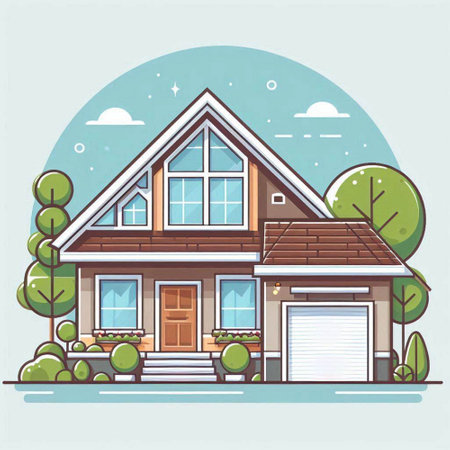Introduction to Decking Materials
When it comes to building a deck that lasts for years, choosing the right materials is one of the most important decisions youll make. A well-built deck not only adds value and beauty to your home but also creates a comfortable outdoor space for relaxing, entertaining, and enjoying nature. However, not all decking materials are created equal. Some require more maintenance, while others offer better resistance to weather, insects, and wear over time.
Whether youre planning a new deck or looking to replace an existing one, understanding the pros and cons of different materials can help you make a smart investment. The two main categories of decking materials are natural wood and composite materials. Each has its own strengths when it comes to durability, maintenance needs, and overall appearance.
Why Material Choice Matters
Your deck will be exposed to sun, rain, snow, and foot traffic year-round. The wrong material choice could mean more frequent repairs, higher maintenance costs, or even the need for early replacement. On the other hand, selecting a material that fits your climate, lifestyle, and design preferences can lead to decades of enjoyment with minimal upkeep.
Key Factors to Consider:
- Durability: How well does the material resist rot, mold, insects, and weather damage?
- Maintenance: Does it need regular sealing, staining, or cleaning?
- Aesthetics: Does it match your desired look—natural wood grain or modern finishes?
- Cost: What’s the upfront price vs. long-term value?
Quick Comparison of Decking Material Types
| Material | Durability | Maintenance | Appearance | Average Lifespan |
|---|---|---|---|---|
| Pressure-Treated Wood | Moderate | High (annual sealing/staining) | Natural wood look | 10–15 years |
| Cedar/Redwood | Good (naturally resistant) | Moderate (regular care needed) | Rich color tones | 15–20 years |
| Tropical Hardwoods (e.g., Ipe) | Excellent | Low to Moderate | Sleek and premium look | 25+ years |
| Composite Decking | Excellent (resists decay & insects) | Low (occasional cleaning) | Wood-like or modern finishes | 25–30+ years |
| PVC Decking | Excellent (fully synthetic) | Very Low (easy to clean) | Smooth or textured styles | 30+ years |
This overview sets the foundation for exploring the best wood and composite options available today. By understanding how each material performs in real-world conditions, you’ll be better equipped to choose one that meets your goals for long-lasting performance and style.
2. Natural Wood Options for Decks
When it comes to building a deck with a natural look and feel, wood is a classic choice that many American homeowners love. Let’s take a closer look at three popular natural wood options: cedar, redwood, and pressure-treated lumber. Each has its own set of benefits and drawbacks, so it’s important to choose the one that fits your budget, climate, and maintenance preferences.
Cedar
Cedar is a softwood known for its beautiful color tones and resistance to rot and insects. It naturally contains oils that help protect it from decay, making it a great option for outdoor decks.
Pros:
- Attractive natural appearance with warm reddish hues
- Resistant to moisture, rot, and insects
- Lighter weight and easier to work with than hardwoods
Cons:
- Softer wood can be prone to dents and scratches
- Requires regular sealing or staining to maintain appearance
- Can be more expensive than pressure-treated lumber
Typical Lifespan:
15–20 years with proper maintenance
Redwood
Redwood is another premium softwood that offers exceptional durability and beauty. It’s especially popular on the West Coast, where its more readily available.
Pros:
- Naturally resistant to decay and pests
- Rich color and grain pattern adds visual appeal
- Stays cool underfoot in hot weather
Cons:
- Higher cost compared to other wood types
- Fades over time without treatment
- Less available in some parts of the U.S.
Typical Lifespan:
20–25 years with regular care
Pressure-Treated Lumber
This is one of the most common and budget-friendly decking materials in the U.S. Pressure-treated lumber is chemically treated to resist rot, moisture, and insects.
Pros:
- Most affordable natural wood option
- Widely available nationwide
- Treated for added durability against weather and pests
Cons:
- May warp or crack over time if not maintained properly
- Chemical treatment may raise environmental concerns for some homeowners
- Aesthetics are less refined compared to cedar or redwood
Typical Lifespan:
10–15 years depending on climate and upkeep
Comparison Table: Natural Wood Decking Options
| Wood Type | Main Advantages | Main Drawbacks | Lifespan (Years) |
|---|---|---|---|
| Cedar | Natural beauty, pest-resistant, easy to work with | Softer wood, needs regular maintenance, moderate cost | 15–20 |
| Redwood | Pest-resistant, rich color, stays cool in heat | Expensive, fades over time, limited availability in some areas | 20–25 |
| Pressure-Treated Lumber | Affordable, durable, easy to find across the U.S. | Lacks aesthetic appeal, can warp/crack, chemical concerns | 10–15 |

3. Composite Decking Materials
Composite decking materials have become a popular alternative to traditional wood thanks to their durability, low maintenance, and resistance to harsh weather conditions. These materials are engineered to last longer and look great with minimal effort, making them a smart choice for busy homeowners.
What Are Composite Decking Materials?
Composite decking is made by combining recycled wood fibers and plastic. This blend creates a strong, moisture-resistant material that doesn’t warp or crack like natural wood. There are two main types of composite decking: wood-plastic composites (WPC) and capped composites.
Wood-Plastic Composites (WPC)
WPC decking is one of the most common types of composite material. It’s created by mixing wood fibers with plastic, resulting in boards that offer the look of wood without the high upkeep.
- Low Maintenance: No need for sanding, staining, or sealing.
- Weather Resistant: Handles rain, snow, and sun better than traditional wood.
- Eco-Friendly: Often made from recycled materials.
Capped Composites
Capped composite decking takes WPC a step further by adding a protective polymer shell around each board. This cap provides extra protection against fading, staining, and mold.
- Extra Durability: The outer shell resists scratches and fading.
- Mold & Mildew Resistant: Better suited for humid or wet climates.
- Longer Lifespan: Typically lasts longer than uncapped options.
Comparison Table: WPC vs. Capped Composites
| Feature | WPC | Capped Composite |
|---|---|---|
| Maintenance | Low | Very Low |
| Weather Resistance | Good | Excellent |
| Mold & Mildew Resistance | Moderate | High |
| Lifespan | 15–20 years | 25+ years |
| Aesthetics | Naturally Wood-Like | Sleek and Uniform Look |
Why Choose Composite Decking?
If youre looking for a long-lasting deck with minimal upkeep, composite materials are a great option. Whether you go with WPC or a capped version, youll enjoy a beautiful deck that stands up to the elements year after year—without the hassle of constant maintenance.
4. Factors to Consider When Choosing Deck Materials
Picking the right decking material is more than just choosing what looks good. To make sure your deck lasts for years and fits your lifestyle, its important to consider a few key factors: climate, budget, sustainability, and your personal style.
Climate Conditions
The weather in your area plays a huge role in how well certain materials hold up. For example, some woods may warp or crack in hot, dry climates, while others resist moisture better in rainy or humid areas.
| Climate Type | Recommended Materials |
|---|---|
| Hot & Dry | Composite decking, Ipe wood |
| Cold & Snowy | Pressure-treated wood, PVC decking |
| Humid & Rainy | Cedar, capped composite decking |
Budget Considerations
Your budget will influence whether you go for natural wood or a low-maintenance composite option. Here’s a quick breakdown of average costs:
| Material Type | Estimated Cost (per square foot) |
|---|---|
| Pressure-Treated Wood | $2 – $5 |
| Cedar or Redwood | $5 – $8 |
| Tropical Hardwoods (e.g., Ipe) | $10 – $15 |
| Composite Decking | $7 – $12 |
| PVC Decking | $9 – $14 |
Sustainability and Eco-Friendliness
If being eco-conscious matters to you, look into sustainably sourced woods like FSC-certified lumber or composite boards made from recycled materials. Composite decking often contains recycled plastics and wood fibers, making it a greener choice for long-term use.
Your Personal Style
The look and feel of your deck should reflect your homes personality. Do you love the natural warmth of real wood? Or do you prefer the clean lines and color options of composite materials?
Style Comparison
| Material Type | Aesthetic Appeal | Color Options |
|---|---|---|
| Natural Wood | Warm and classic with visible grain patterns | Limited; can be stained or painted |
| Composite Decking | Sleek and uniform appearance | Wide range of factory-finished colors and textures |
Taking all these factors into account will help you choose a deck material that not only lasts but also fits your home’s environment, your budget, and your personal taste.
5. Maintenance Tips for Extending Deck Lifespan
Keeping your deck in good shape doesn’t have to be hard, but it does require some regular care. Whether you have a wood or composite deck, following simple cleaning, sealing, and inspection routines can go a long way in extending its lifespan.
Routine Cleaning
Cleaning your deck removes dirt, mold, mildew, and debris that can cause damage over time. Here’s how often you should clean:
| Deck Material | Cleaning Frequency | Recommended Cleaning Method |
|---|---|---|
| Wood | Twice a year (Spring & Fall) | Sweep regularly; wash with a mild deck cleaner and water |
| Composite | Every 3-4 months | Sweep regularly; use a manufacturer-approved composite deck cleaner |
Sealing and Staining (For Wood Decks)
Wood decks need protection from moisture and UV rays. Sealing and staining help preserve the wood and maintain its appearance.
When to Seal or Stain:
- New Decks: Wait 3-6 months before sealing to allow the wood to dry out.
- Existing Decks: Reseal every 1-2 years depending on exposure to sun and rain.
Tips for Best Results:
- Clean the deck thoroughly before sealing or staining.
- Choose a dry day with temperatures between 50°F and 90°F.
- Use a brush or roller designed for outdoor wood finishes.
Inspection Checklist
A quick check a couple of times a year can help catch small problems before they become big ones. Use this checklist:
| Area | What to Look For | Action Needed |
|---|---|---|
| Boards and Planks | Cracks, splinters, warping | Replace damaged boards; sand down rough spots |
| Nails and Screws | Popped or rusted fasteners | Tighten or replace with corrosion-resistant hardware |
| Support Structure | Mold, rot, or insect damage under the deck | Treat affected areas or consult a professional if needed |
| Railings & Stairs | Loose connections or wobbly parts | Tighten screws; reinforce weak areas |
Caring for Composite Decks
Composite materials are low maintenance but not maintenance-free. Here’s how to keep them looking great:
- Avoid using harsh chemicals or pressure washers that can damage the surface.
- Cleans stains like grease or mildew promptly with warm soapy water and a soft brush.
- If mold appears, use a composite-safe mold remover as recommended by the manufacturer.
A Little Effort Goes a Long Way
No matter what material your deck is made of, regular care helps it stay safe, attractive, and durable for years. Stick to these simple tips and enjoy your outdoor space worry-free season after season.


